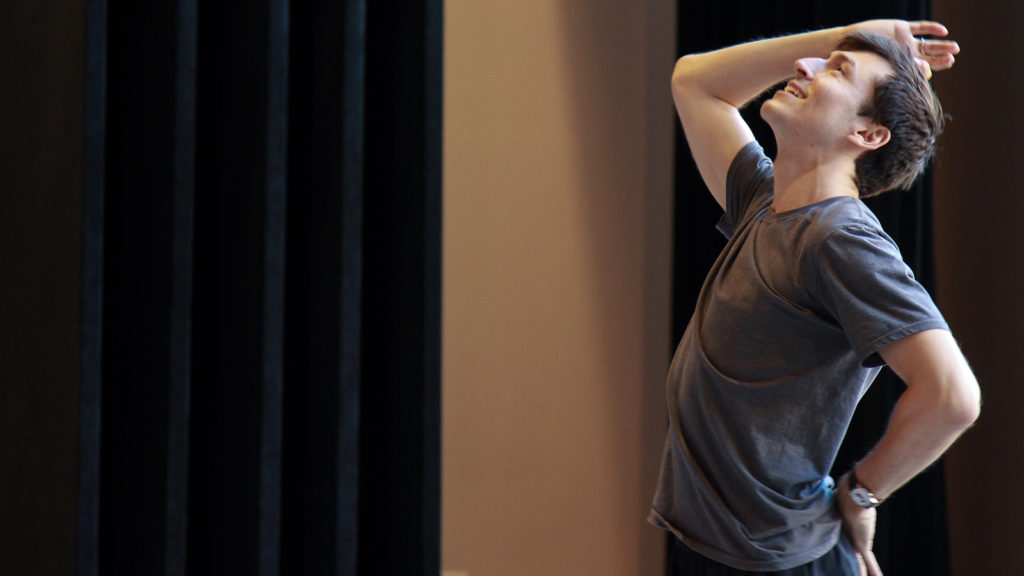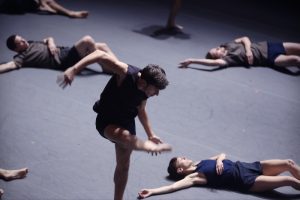Bret Easterling discusses the nuances of online dance
August 31, 2020

Bret Easterling teaches class | Photo by Benjamin Peralta
Bret Easterling, USC Glorya Kaufman School of Dance lecturer, had a summer full of Gaga. Now, he is ready to take on a full semester of teaching it to BFA and elective students alike. This movement language, developed by Ohad Naharin, focuses on guided improvisation through the exploration of physical sensations and available movement options.
Summer of Gaga
This summer, Easterling taught many online Gaga classes. He was also able to engage with the founder of this movement language while quarantining in Half Moon Bay, Calif.
“An aspect of these Gaga online classes that happened over the summer was that the creator and developer of this language, Ohad Naharin, was very present in witnessing our classes and providing feedback,” Easterling said. “There was a lot of evolution going on during the summer of teaching classes. Also, Naharin became more accessible with regards to Zoom because he’s based in Israel.”
Exploring Gaga at USC
As a part of the greater USC Welcome Experience, Easterling taught an introductory Gaga class through Zoom on August 18. The class was attended by current USC students, alumni and some prospective students, according to Easterling.
“There was a senior in high school that was there and asked me a question after, which was really meaningful,” Easterling said. “It’s always my goal to make sure that I’m offering the people in the room a meaningful physical experience. That they potentially achieve or gain something that they didn’t have before with regards to an awareness of their body. I want them to explore the scope of sensations they can harness and challenge students to go beyond familiar limits.”
The move to Zoom
Last semester, Easterling taught Gaga and Repertory and Performance for BFA students. Each class proved to have different experiences when USC Kaufman moved to online learning in March. Gaga transitioned smoothly to an online format, Easterling said. This was because Gaga hinges on a dancer’s individual experience. On the other hand, Repertory and Performance posed some obstacles. Easterling was teaching Naharin’s “Minus 16,” which was to be performed at USC Kaufman’s debut at The Broad Stage in April.
“Rep and Performance was a bit challenging to translate immediately. Every student was in a very different situation and in different places dealing with different things,” Easterling said. “I had to look through the catalogue in my brain of Naharin’s repertory that was stationary. I then pulled as many things as I could and started teaching the students these phrases.”
Even though Easterling’s Repertory and Performance class could not perform their work on stage, he stressed that performance can manifest in other ways.
“The act of performing can also be recognizing that you don’t need an audience to engage in your own performance,” Easterling said. “I wanted my students to notice the physical differences between when you feel like you are performing versus when you are not and try to bridge the gap between those ideas.”
Personal connection through virtual class
Looking toward a full semester online, Easterling explained that his main goal is to give students the ability to connect to pleasure through dance.
“It’s really huge these days, when we’re in our homes, to be able to create a physical experience that can give pleasure,” Easterling said. “I want to empower the students to discover ways that they can do this for themselves. They don’t need me in order to connect to their own physical sensations and their own kind of joy.”
Easterling advises anyone hesitant to take an online dance class to focus simply on dance as movement. He sees the virtual experience as an accessible tool on the journey to personal and physical connection.
“All of us are constantly moving and involved in choices that decide how we move. Whether it’s how you’re walking, how you dry off after the shower or the order in which you get ready for bed,” Easterling said. “These are all choreographic choices that we’re making. It might feel wrong to be learning something that is so physical through a virtual setting. But I think at the same time, this is a pivotal moment where we can all connect to our physical selves.”
DANC 190 Gaga: People is a 1 to 2 unit class open to all individuals, regardless of previous dance experience. Learn more about this class and others open to all USC students.
By Brigid Murphy
